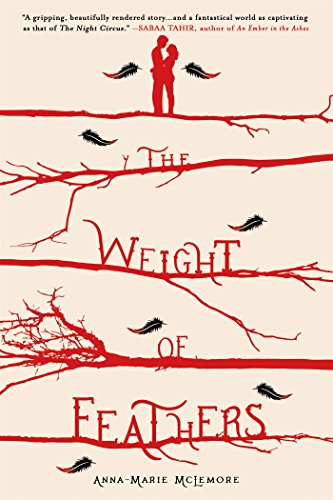
![]() The Weight of Feathers by Anna-Marie McLemore
The Weight of Feathers by Anna-Marie McLemore
The Romeo and Juliet story is updated with a few twists in Anna-Marie McLemore’s debut young adult fantasy novel, The Weight of Feathers, published September 15, 2015. Two rival families travel between small towns in California in a nostalgic setting that seems to be approximately the 1960s, performing their Cirque du Soleil-type acts for the townspeople. The French Romani Corbeaus (“Ravens”) attach wings made of wire and feathers to their bodies and perform acrobatics in the treetops; the young women in the Latino Paloma family (“Doves”) dress up as mermaids and do mystic underwater dance routines. What outsiders do not know is that the Corbeaus actually grow feathers in their hair, and the Palomas have escalas, small scattered birthmarks that look like fish scales.
For the last twenty years, the Corbeau/Paloma feud has taken a bitter turn, to the point where the families try to sabotage each other, and anyone touching a member of the other clan — other than in a fight — will be exiled from the family.
Fighting was the only safe way to touch a Paloma… The rage made it good and true. The anger and honor of defending this family shielded them like a saint’s prayer. Hitting and kicking were safe. Anything else could bring sickness.
Each family is convinced that the members of the other family are completely, utterly and despicably in the wrong.
The Weight of Feathers alternates between the viewpoints of two teenage members of these families: Lace Paloma, who struggles with staying thin enough to be considered a worthy member of the mermaid performers, and a Corbeau boy called Cluck, who works behind the scenes, fixing the performers’ feathered wings and performing other odd jobs, because an old injury to his hand prevents him from joining the performances. Cluck is an outsider in his own family, doing odd things like wearing his grandfather’s old clothes, and being bullied by other Corbeaus, especially his brother Dax. Both Lace and Cluck feel alienated, struggling with the superstitious rigidity and unreasoning anger and abuse that runs through their families.
When Lace and Cluck first meet each other in the town of Almendro, neither realizes that the other is a member of their rival clan. But a tragic industrial accident in the town brings Lace and Cluck back together. Cluck, in seeking to help Lace, unwittingly leads to Lace’s expulsion from the Paloma clan: a feather-shaped burn mark on her arm is the proof, at least to Lace’s abuela, who rules the Palomas with an iron fist, that Lace has committed the unpardonable sin of allowing a gitano (gypsy) boy to touch her. And Lace, believing that Cluck’s forgiveness for her earlier rudeness to him will remove the feather brand from her arm, allows him to take her to meet his family without telling him that she’s a Paloma. Inevitably the truth will out, but by then the attraction between them has taken hold, and even a bitter feud isn’t enough to erase it. Hope is, also, a thing with feathers.
She was there to pull Cluck to his feet and keep him there if he couldn’t stand. To make sure none of the pieces of him got lost if he broke. In case his mother, neat as a greenhouse tulip, failed to notice that he was not dust or cracked glass, and reached for a broom.
The evocative, dreamlike words and imagery throughout The Weight of Feathers tend to obscure the fact that these families are so dysfunctional and abusive. And yet there is love there too, enough to make it difficult for Lace and Cluck, or any member of their families, to break the cycle of hatred, where doing so requires them to also break the ties that bind them to their families.
The Weight of Feathers is peppered with words and phrases in both Spanish and French (I made liberal use of my Kindle’s automatic translation feature). Each chapter begins with an appropriate saying in French or Spanish; these, at least, are translated for the reader. The families’ different cultures and backgrounds add a welcome element of depth to this otherwise familiar story of two star-crossed young lovers. And there are some unexpected turns in the plot that make this more than just a modern retelling of Romeo and Juliet.
This story is, at heart, a young adult romance spiced with some magical realism. The lovely, haunting language makes The Weight of Feathers a better-than-usual entry in the young adult fantasy romance genre, but I wouldn’t recommend it to any readers who don’t enjoy fantasy romances. However, those who do enjoy sweet romances tinged with a magical element will find ample rewards, and even some food for thought, in the pages of this novel.



Great review! The R+J/circus combination sounds similar to Girl on a Wire, by Gwenda Bond — have you had a chance to read that one also?
I’ve heard of Girl on a Wire but haven’t read it, Jana – I’ll have to keep an eye out for it. This book is also being compared to The Night Circus, and it is kind of a young adult variant of that book. Personally I liked The Night Circus better, though. The fantastical element was stronger.
I actually haven’t read The Night Circus — is it that good?
For me The Night Circus was a 5-star read, but I think it’s one of those YMMV (your mileage may vary) books. Dueling magicians who fall in love, fantastical magical circus, very evocative and lovely language. It just hit all of the right buttons for me, but I hesitate to say that you’ll love it. It depends on your enjoyment of this type of fantasy.
Hmmm…. Well, I’ll give it a shot at some point. :) Thanks!